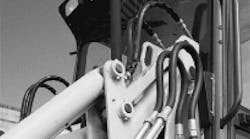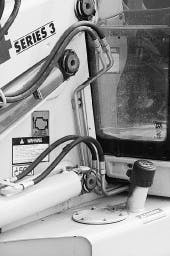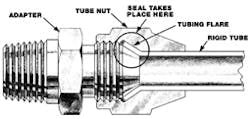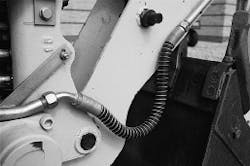This file type includes high resolution graphics and schematics when applicable.
Components on many types of hydraulic equipment are connected by rigid tubing. Being rigid, however, tubing can transmit vibration from one component to another throughout an assembly. Increasingly, designers of hydraulic systems are integrating bent tubes and hoses into hybrid bent assemblies. These assemblies provide the weight and bend advantages of bent tube with the flexibility and vibration dampening characteristics of hose.
Metal tube is economical and exhibits a long service life. For equipment manufacturers, bent tubing has traditionally offered additional advantages over hose such as:
- better heat dissipation
- smaller allowable bend radii
- lighter weight (which is important on long boom arm applications), and
- the ability to handle pressures above 6,000 psi.
Tubing can take a great deal of punishment under tough service conditions. Seamless and welded steel tubing conforming to SAE standards is widely used in medium and high-pressure applications. Stainless steel tubing is used in very high-pressure applications or where corrosion of carbon steel presents a potential problem. (Copper tubing also can be found, but mainly on low-pressure applications.)
On the down side, tubing is subject to corrosion unless it is specially treated. In addition, it must be shaped using sophisticated bending equipment and may require special fittings and considerable labor to install.
Hose assemblies, on the other hand, are less likely to transmit vibration because they tend to dampen pressure surges and pulsations. This ability to absorb vibration not only reduces noise, but helps improve reliability and extend the life of the hydraulic system.
Lighter, stronger, more flexible
At one time, equipment manufacturers specified hose primarily when dynamic bending of hydraulic lines was necessary. If the hydraulic line didn't need to bend, metal tubing was almost always preferred. Today, designers of mobile equipment in particular are learning to optimize designs by specifying hybrid steel-tube/hose assemblies - especially in applications where vibration is severe. A feasible alternative to port-to-port steel tube assemblies is to connect steel tubing to a port, then run a length of hose to the other component. Some designers even replace steel tubing altogether with a single hose assembly when application parameters permit.
An example of how hybrid steel-tube/hose assemblies work together is exhibited on agricultural equipment that include 60-ft long boom attachments. In the past, manufacturers have preferred to use bent tube assemblies on these attachments in order to minimize weight and prolong the life of the tool bar. However, manufacturers today recognize that these attachments generate vibration, which is a major factor leading to system failure. Their solution to this problem has been to use primarily hose assemblies where the structure can tolerate the higher weight and a bent tube/hose combination where light weight is more critical.
With the development of newer and stronger thermoplastics for use in hydraulic hose, the decision between using steel tubing or hose has become less clear cut. This is because new generations of lighter-weight, high-pressure hydraulic hose have narrowed the gap between the lower weight and tighter bend radius advantages of steel tubing over hose. Many of the latest designs allow the hose to bent at half the standard SAE bend radius - even when pressure impulses are present. This construction makes the hose much more flexible and easier to route through tight spaces.
In critical routing situations, half-bend radius hoses allow considerable flexibility in bridging port-to-port routing. With steel tubing, the connecting section must match up exactly with component ports to avoid placing stress on the fittings, which often are brazed or welded to the tube. This makes the connection susceptible to damage and cracking at the joint - especially if vibration is present.
Specifying hose has also become easier because manufacturers have developed selection procedures based on working pressure ratings rather than dimensions and construction criteria standardized by SAE. This means that selecting hose from a broad range of styles and sizes no longer requires a knowledge of SAE dimensional specifications and performance parameters.
The effects of heat
Although tubing is considered a better heat dissipator than hose, the increasing use of load-sensing hydraulics has resulted in cooler-running hydraulic systems, so heat dissipation has become less of a concern. The thinner walls in today's hydraulic hoses also reduce the insulation properties that can contribute to heat buildup under certain situations. In some applications, the use of hose can actually result in less heat buildup because of improved laminar flow through the more gradual bends created between hose connections.
Furthermore, the insulating effect of hose can be an advantage for equipment operated in cold environments. In this situation, the hose helps retain heat, which helps bring the hydraulic fluid to operating temperature more quickly.
And, finally, keep in mind that hose should not be used where it will contact or be in close proximity to an ignition or heat source, such as engine exhaust system components. Placing hose near a heat source not only can compromise safety, but degrade life of the hose as well. An increase of 18° F above the maximum ambient temperature rating of a hose may cut its life in half. However, many of today's hoses can tolerate higher temperatures with no degradation in performance.
Getting connected
Whenever a hydraulic hose and steel tube are connected, a leak-proof seal must be established that can stand up to vibration and shock impulses. A variety of connection methods have been developed to connect tubing to hydraulic hose, including flaring, brazing or the use of special tube fittings.
One of the most popular attachments is the comparatively simple 2-piece flared tube connection. SAE originated the 45° flare design, shown below, to connect hose and low-pressure copper tubing for trucks. Engineers found they could attach a piece of hose by putting a threaded female swivel on the tube and then flaring the end of the tube to a 45° angle. The flare on the end of the metal tube keeps the female fitting from sliding off the end of the tube and provides a seating surface for a leak-tight seal. The male end of a fitting with the same flare angle threads into the female fitting, and the angles of the two flared surfaces form a leak-proof seal.
The development of higher pressure hydraulic systems required stronger fluid lines than could be achieved with once-prevalent copper tubing. Consequently, steel tubing came into widespread use for hydraulics. A 37° seat angle was adopted for steel tubing because it could not be reliably flared to an angle greater than 37° without weakening it. Except for the seat angle, this design closely resembles the SAE 45° flare. Although 45° and 37° flare fittings appear identical, the two different seat angles are not compatible. If an SAE 45° flare and a 37° flare are threaded together, the male and the female seats will not mate properly.
Several flareless tube fittings also are available from various manufacturers. One design uses a tapered split ring in conjunction with an O-ring to form a leak-tight seal. Another type of O-ring design uses straight threads to form the connection, but the O-ring to make the seal. The O-ring fits into a groove around the opening of the female-threaded counter port in a component or valve. Straight thread fittings are not as likely to crack a port manifold as are tapered thread connectors. The O-ring, which normally is made from synthetic rubber, provides the seal and is compatible with various hydraulic fluids.
Some tube-end fittings are secured by brazing or welding. A fitting end socket slides onto the tube and is welded into position to form a tube-end connection. This method is economical, especially when special configurations are needed in mass production. Another technique uses a machine that cold-works the tube end into a mounting flange used in conjunction with a swivel body that fits around the tube.
SAE hose fittings often consist of a metal tube flared to 45° in a female cone into which the male fitting can be tightened and mated with the flared surface of the tube. The female cone acts as a swivel that can be detached and re-assembled many times without affecting the efficiency of the seal.
Replacing tube with hose
The convenience and routing advantages of hose means it is not uncommon for maintenance personnel to replace an unserviceable, hard-to-reach, bent tubing assembly with a hose assembly. When considering hose to replace a bent tube assembly, it is important to check the manufacturer's specifications for both pressure and temperature ratings, and determine the correct inside and outside hose diameters using a precision-engineered caliper. Hose outer diameter is especially important when hose routing clamps are used or when hoses are routed through bulkheads. Check individual hose specification tables for outer diameters in suppliers' catalogs.
The hose ID must, of course, be large enough to handle the required fluid flow rate without generating excessive backpressure. It is not uncommon for pumps to deliver more than 200 gpm of fluid to hydraulic cylinders and motors in various types of equipment, which is why it is important to know the type of hose and the working pressure in a system when making replacements. Computerized inventory and cross-reference support programs from hose manufacturers enable many distributors to identify and make replacement assemblies for end users in minutes.
In situations where hydraulic equipment has been modified to perform special operations, you should expect pressure spikes to occur that may affect life or performance of the hose, fitting, or both. This happens when equipment is modified to increase operating pressure or flow without upgrading fluid conductors. As a general rule, when choosing hose as a replacement for tubing, it's best to allow a generous margin of safety.
Hose routing guidelines
Always allow for expansion and contraction of the hose during operation by making the hose lengths slightly longer than the actual distance between the two connections. When pressurized, hose length can increase as much as 2% or decrease by as much as 4%.
If the replacement hose is too short, pressure may cause the hose to contract and be stretched, leading to reduced service life. But if a hose is too long, it can be damaged, pinched, or even severed if it gets in the way of moving machine members.
Also avoid positioning hose next to metal edges or too close to other hose. Continuous rubbing against equipment components, other hose, or objects in the operating envelope can wear away the hose cover, exposing the hose reinforcement. Once a hose's protective cover has worn away, the exposed reinforcement wires become susceptible to corrosion, wear, and, ultimately, premature failure.
Prevent abrasion by bundling together hose assemblies that flex in the same direction. Clamps, bent tube elbows, nylon ties, spring guards, and sleeves can be used to keep hose away from abrasion sources. Hose sleeves can be used to provide extra protection from abrasion. Major hose manufacturers also produce hoses with extra-tough, abrasion-resistant covers that last hundreds of times longer than standard rubber-covered hoses in hose-to-hose and hose-to-metal abrasion testing.
Use elbows and adapters to prevent inducing strain on hose assemblies and to provide neater installations that are more accessible for inspection and maintenance. Elbows and adapters also can prevent having to orient fittings in a specific position during installation.
If an angle fitting is required on both ends of a hose assembly, use it on one end only, then use a straight fitting and an angle adapter on the other. In general, it is better to use a straight adapter and bent tube fitting instead of an angled adapter and straight hose end. This promotes laminar flow, which reduces pressure drop.
And, finally, adapters should be permanently installed on tapered pipe thread ports as a way to upgrade connections to modern designs that are more reliable and leak-free.
This file type includes high resolution graphics and schematics when applicable.






